
Sixth-formers enjoyed some traditional food – as well as plentiful helpings of History and Politics – on their trip to Russia.
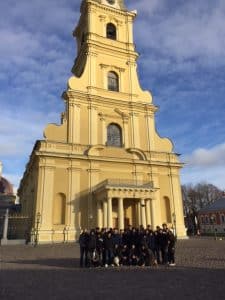 The party of 30 boys from Years 12 and 13, along with four members of staff, landed in Moscow for a six-day, two-city tour, during which they learned more about Russian life, from the era of the Tsars through the soviet period and up to the present day.
The party of 30 boys from Years 12 and 13, along with four members of staff, landed in Moscow for a six-day, two-city tour, during which they learned more about Russian life, from the era of the Tsars through the soviet period and up to the present day.
Helen MacGregor, Head of History, said: “It was a great trip; the boys really got into the culture of the country. The visit not only increased their understanding of their A-level History material but also of modern-day politics, including the reasons for the evident popularity of President Putin among Russian voters.”
Among the highlights were visits to Red Square and to the dark marble pyramid that is Lenin’s Mausoleum. “He died in 1924 and the boys have learned so much about him, so it was amazing to actually see him,” said Miss MacGregor. The boys also saw Stalin’s resting place in the Kremlin Wall Necropolis.
In the afternoon they had a guided tour of the Novodevichy Cemetery. Constructed in 1898 its importance dates to the 1930s when it became home to the remains of famous Russians whose bodies were disinterred when Stalin ordered the demolition of the abbeys. Anton Chekhov, Nikita Kruschev and Boris Yeltsin are among those buried at Novodevichy.
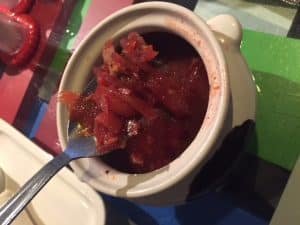 In the evening there was a total change of mood with a visit to the HC Spartak Ice Hockey stadium. The group stayed in a hotel for the first night where they partook of traditional Russian fare, namely borscht and cabbage soup. “The boys enjoyed trying the local food, but Moscow’s McDonalds was also a hit,” added Miss MacGregor.
In the evening there was a total change of mood with a visit to the HC Spartak Ice Hockey stadium. The group stayed in a hotel for the first night where they partook of traditional Russian fare, namely borscht and cabbage soup. “The boys enjoyed trying the local food, but Moscow’s McDonalds was also a hit,” added Miss MacGregor.
After a second day of sightseeing in Moscow, which took in the Patriotic War Museum and the Metro, the boys relished a game of bowling. They then took the Grand Express overnight train to travel the 800 kms to St Petersburg. “It was so exciting to be whizzing through Russia in the dark to arrive in St Petersburg the following morning,” said Miss MacGregor.
 “The boys were blown away by the beauty of the palaces there. So much gold and decoration, including the Amber Room in the Catherine Palace, which had to be recreated after it was dismantled and disappeared during WWII, presumably looted by the Nazis.”
“The boys were blown away by the beauty of the palaces there. So much gold and decoration, including the Amber Room in the Catherine Palace, which had to be recreated after it was dismantled and disappeared during WWII, presumably looted by the Nazis.”
Whilst in St Petersburg, the boys went to a Soviet Arcade Machine Museum where they tried out a selection of old games, including pinball and table football.
On the final morning, the boys went to the Hermitage Museum, which boasts the second largest art collection in the world, ranked second only to The Louvre in Paris. The museum and gallery were founded by Catherine the Great and house a collection of more than 3 million items, although only a small proportion is on public display at any one time.
Miss MacGregor said: “Trips both support what the boys learn in the classroom whilst offering them unique enrichment opportunities. They returned with much greater insight into the topics they have been studying, having had a thoroughly enjoyable experience.”

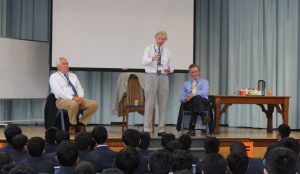 Ken Cooper (OE 1942–1950), David Farrer (1954–1961) and John Todd (1958–1964) were introduced by Head of History Helen MacGregor. There was an opportunity for the Year 7 boys to ask them questions, which typically focused largely on the disciplinary regime of the time!
Ken Cooper (OE 1942–1950), David Farrer (1954–1961) and John Todd (1958–1964) were introduced by Head of History Helen MacGregor. There was an opportunity for the Year 7 boys to ask them questions, which typically focused largely on the disciplinary regime of the time!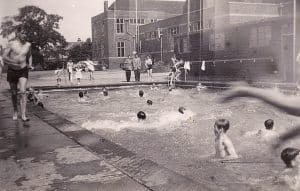 At first, all that lay behind the Main Building was the ‘Gun Field’. Later, an unheated, open-air swimming pool was built; boys were expected to swim in it in all weathers.
At first, all that lay behind the Main Building was the ‘Gun Field’. Later, an unheated, open-air swimming pool was built; boys were expected to swim in it in all weathers.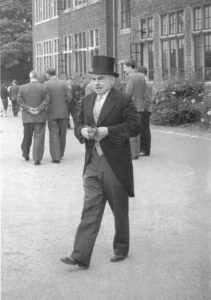 During his tenure, the strictness of the regime was seen in the use of corporal punishment. The cane was still very much in use and boys could, in the schoolboy slang of the time, be ‘whacked’ for a variety of misdemeanours. The three alumni reported, though, that they accepted this as being a normal part of school education and thought that there was usually good reason for the punishment! Mr Todd recalled going to be caned and being asked to select which of three different canes should be used. He remembered being concerned that it would be very obvious that he had hidden a workbook down the back of his trousers to cushion the blows, although this was, in fact, not commented upon by the master.
During his tenure, the strictness of the regime was seen in the use of corporal punishment. The cane was still very much in use and boys could, in the schoolboy slang of the time, be ‘whacked’ for a variety of misdemeanours. The three alumni reported, though, that they accepted this as being a normal part of school education and thought that there was usually good reason for the punishment! Mr Todd recalled going to be caned and being asked to select which of three different canes should be used. He remembered being concerned that it would be very obvious that he had hidden a workbook down the back of his trousers to cushion the blows, although this was, in fact, not commented upon by the master.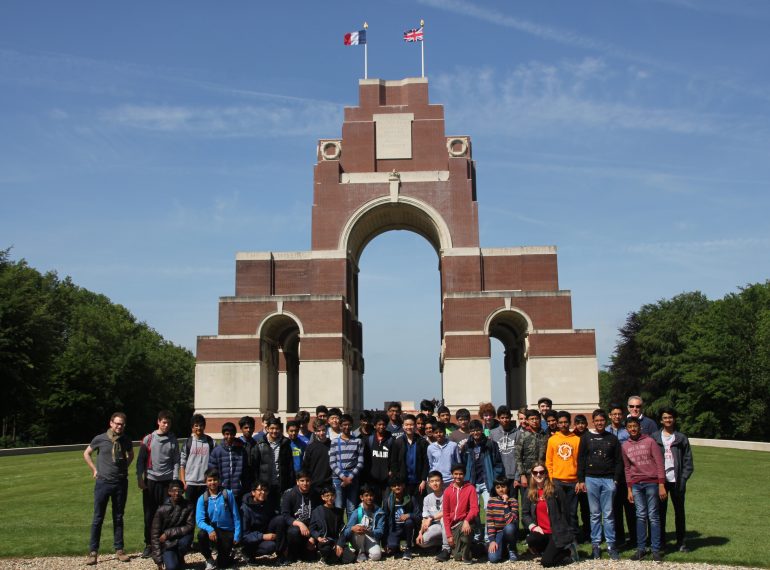
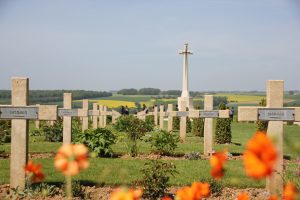 History teacher Simon Walker said: “The trip was important both emotionally and analytically, helping students understand how trench warfare worked and appreciate the experience of those who fought, as well as giving them an opportunity to reflect on the cost of war and consider what we can learn from the way soldiers have been memorialised.”
History teacher Simon Walker said: “The trip was important both emotionally and analytically, helping students understand how trench warfare worked and appreciate the experience of those who fought, as well as giving them an opportunity to reflect on the cost of war and consider what we can learn from the way soldiers have been memorialised.”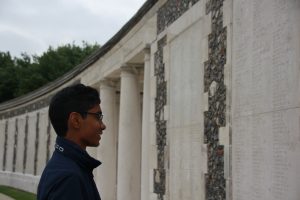 One striking contrast was seen in the ways the fallen were commemorated at:
One striking contrast was seen in the ways the fallen were commemorated at: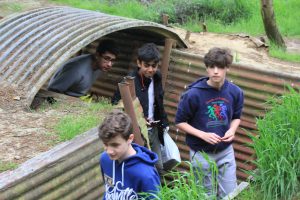 Other memorable highlights of the trip to the sites in France and Belgium included the sight of Lochnagar Crater, the biggest crater of World War I, where boys learned about tunnelling and the use of mines. They attended the Last Post ceremony at Menin Gate in Ypres to commemorate soldiers lost in the 1914–1918 – a ceremony performed every evening since 1927, even during World War II. They also learned how medical provision developed during the conflict, visiting a field hospital where John McCrae worked as a surgeon and composed his famous poem, In Flanders Fields.
Other memorable highlights of the trip to the sites in France and Belgium included the sight of Lochnagar Crater, the biggest crater of World War I, where boys learned about tunnelling and the use of mines. They attended the Last Post ceremony at Menin Gate in Ypres to commemorate soldiers lost in the 1914–1918 – a ceremony performed every evening since 1927, even during World War II. They also learned how medical provision developed during the conflict, visiting a field hospital where John McCrae worked as a surgeon and composed his famous poem, In Flanders Fields.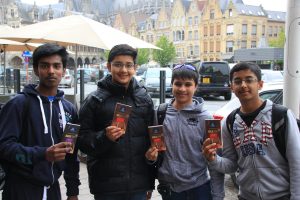 There were lighter moments, too, including a popular visit to the Leonida chocolate shop and the time when the boys’ keen-eyed coach driver spotted a World War I wire fence post unearthed and left at the roadside by a local farmer.
There were lighter moments, too, including a popular visit to the Leonida chocolate shop and the time when the boys’ keen-eyed coach driver spotted a World War I wire fence post unearthed and left at the roadside by a local farmer.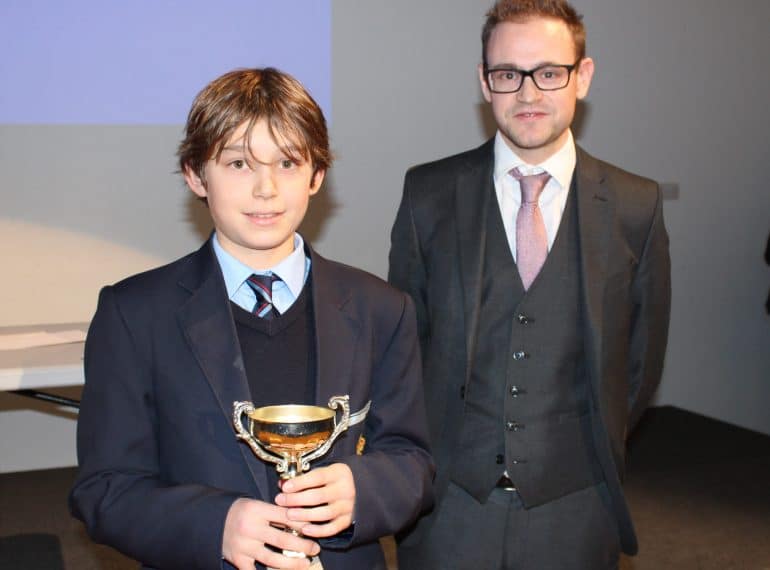

 Said to have first been used as a battle cry by Richard I as long ago as the 12th century, it remains in use to this day. But why, the boys wondered, was it so prominent at Hampton Court – a palace built more than 300 years after the words were first spoken? The Chapel Royal there has it written on the ceiling no fewer than 32 times!
Said to have first been used as a battle cry by Richard I as long ago as the 12th century, it remains in use to this day. But why, the boys wondered, was it so prominent at Hampton Court – a palace built more than 300 years after the words were first spoken? The Chapel Royal there has it written on the ceiling no fewer than 32 times!